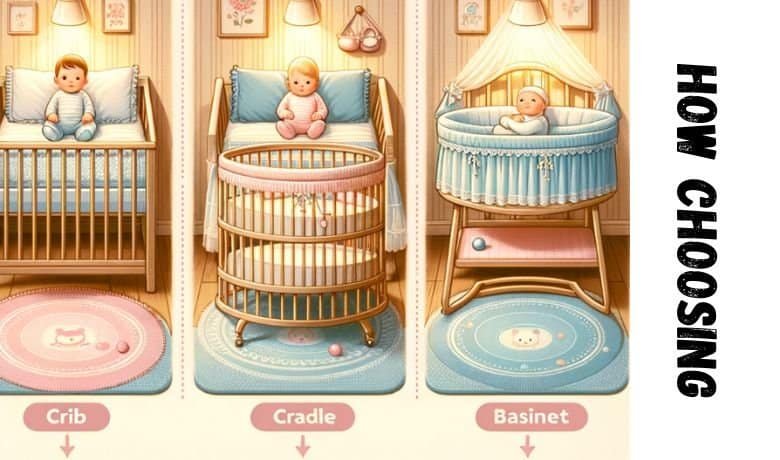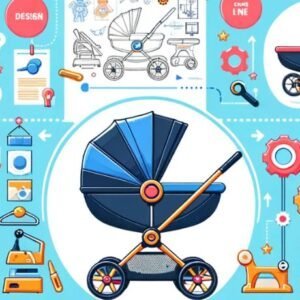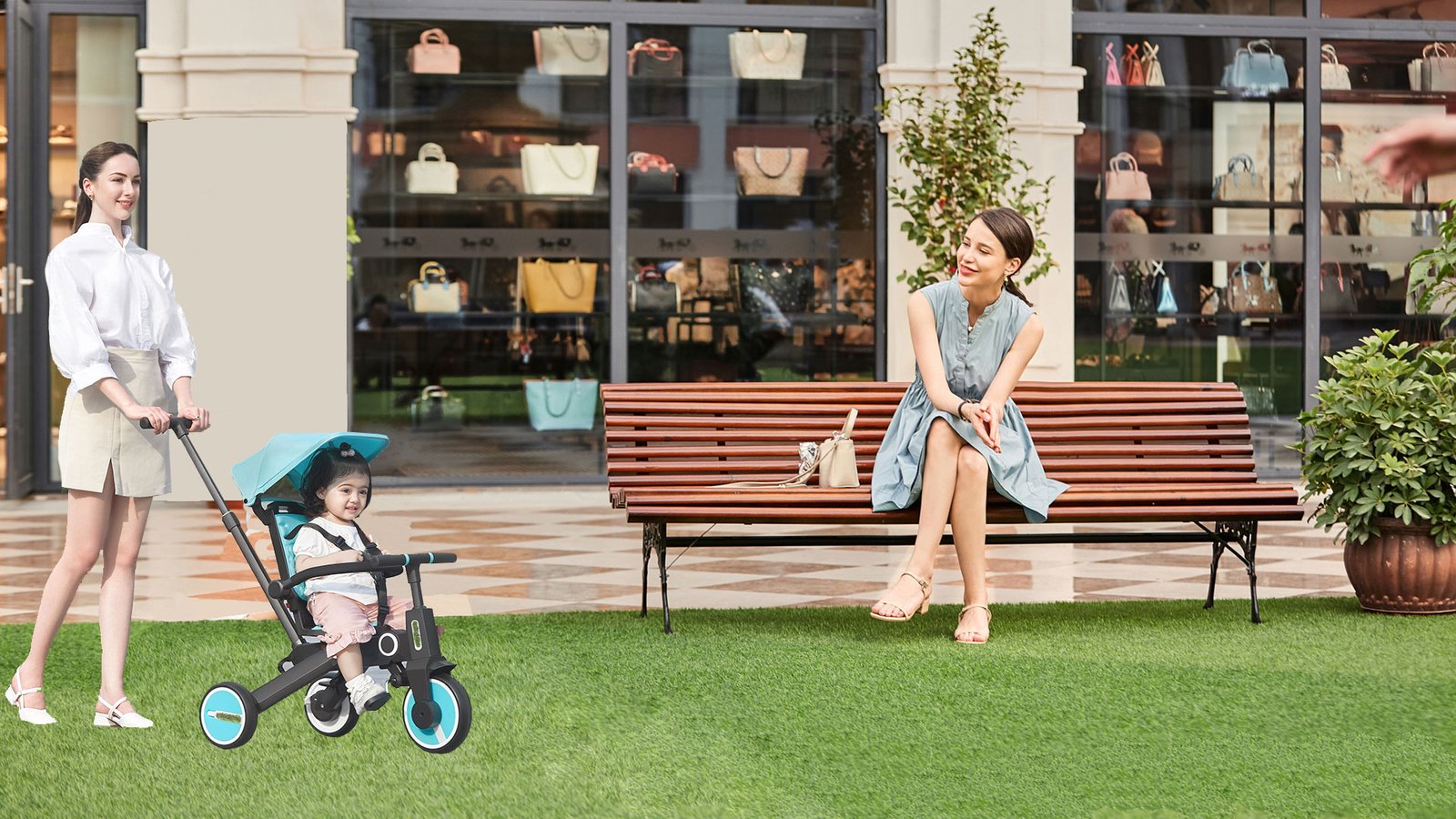Welcome, new parents! Congratulations on the arrival of your little bundle of joy. One of the many important decisions you’ll need to make in the early days is choosing the right bed for your baby. There are three main types of baby beds available: cribs, cradles, and bassinets. Each type has its own unique advantages and disadvantages, so it’s important to weigh your options carefully before making a decision.
This blog post will provide you with a comprehensive guide to choosing the best bed for your baby. We’ll discuss the different types of baby beds in detail, and we’ll provide tips on how to choose the safest and most comfortable bed for your little one.
Different Types of Baby Beds
- Crib: Cribs are the most common type of baby bed. They are typically larger and more sturdy than cradles and bassinets, and they can be used from newborn to toddler age. Cribs also have a variety of features, such as adjustable mattress height and removable sides, which can make them more convenient and versatile than other types of baby beds.
- Cradle: Cradles are smaller and more portable than cribs. They are often used for newborns and young infants, as they can provide a more cozy and enclosed sleeping environment. Cradles may also have rocking or swinging features, which can help to soothe and calm babies.
- Bassinet: Bassinets are the smallest and most lightweight type of baby bed. They are ideal for newborns and very young infants, as they can be placed close to the parents’ bed for easy access. Bassinets are also portable, so they can be easily moved from room to room.
The purpose of this blog post is to provide parents with a comprehensive guide to choosing the best bed for their baby. We will discuss the different types of baby beds in detail, and we will provide tips on how to choose the safest and most comfortable bed for your little one. We also hope to answer some of the most common questions that parents have about baby beds, such as:
- What is the best bed for a newborn?
- When should I transition my baby from a bassinet to a crib?
- What is the safest type of baby bed?
- What should I look for when buying a crib, cradle, or bassinet?
We hope that this blog post will help you to choose the best bed for your baby, so that you can all get a good night’s sleep!
What is the difference between a crib, a cradle, and a bassinet?
Crib vs. Cradle vs. Bassinet: A Detailed Comparison
Size:
- Crib: Cribs are the largest of the three types of baby beds. They typically measure around 52 inches long and 28 inches wide.
- Cradle: Cradles are smaller than cribs, but they are still larger than bassinets. They typically measure around 36 inches long and 20 inches wide.
- Bassinet: Bassinets are the smallest of the three types of baby beds. They typically measure around 30 inches long and 18 inches wide.
Portability:
- Crib: Cribs are not very portable. They are typically made of sturdy materials and are designed to be set up in one location.
- Cradle: Cradles are more portable than cribs, but they are still not as portable as bassinets.
- Bassinet: Bassinets are the most portable of the three types of baby beds. They are typically made of lightweight materials and have handles or wheels, making them easy to move from room to room.
Features:
- Crib: Cribs have a variety of features, such as adjustable mattress height, removable sides, and drop-down rails. Cribs may also have additional features, such as storage drawers or changing tables.
- Cradle: Cradles may have rocking or swinging features, which can help to soothe and calm babies. Cradles may also have canopies or other decorative features.
- Bassinet: Bassinets typically do not have as many features as cribs or cradles. However, some bassinets may have features such as mesh sides for airflow or removable inserts for co-sleeping.
Safety:
All three types of baby beds must meet certain safety standards in order to be sold in the United States. However, there are a few additional safety features that parents should look for in a baby bed:
- Crib: Cribs should have slats that are spaced close together to prevent babies from getting their heads stuck. Cribs should also have a sturdy frame and drop-down rails that lock securely.
- Cradle: Cradles should have a sturdy frame and a secure rocking or swinging mechanism. Cradles should also have a safety strap to prevent babies from falling out.
- Bassinet: Bassinets should have a sturdy frame and mesh sides for airflow. Bassinets should also have a safety strap to prevent babies from falling out.
Pros and Cons of Each Type of Bed
Crib
- Pros: Cribs are the most versatile type of baby bed. They can be used from newborn to toddler age, and they have a variety of features that make them convenient and comfortable for babies.
- Cons: Cribs are not very portable, and they can be expensive.
Cradle
- Pros: Cradles are more portable than cribs, and they can provide a more cozy and enclosed sleeping environment for newborns. Cradles may also have rocking or swinging features, which can help to soothe and calm babies.
- Cons: Cradles can be expensive, and they can only be used for a short period of time, as babies will quickly outgrow them.
Bassinet
- Pros: Bassinets are the most portable and affordable type of baby bed. They are also ideal for newborns, as they can be placed close to the parents’ bed for easy access.
- Cons: Bassinets can only be used for a short period of time, as babies will quickly outgrow them. Bassinets may also not have as many features as cribs or cradles.
Which Type of Bed is Right for You?
The best type of bed for your baby will depend on your individual needs and preferences. If you are looking for a versatile bed that can be used for a long period of time, a crib is a good option. If you are looking for a more portable bed for a newborn, a cradle or bassinet is a good option.
Ultimately, the best way to choose the right bed for your baby is to consider your specific needs and budget. You may also want to talk to other parents to get their recommendations.
| Feature | Crib | Cradle | Bassinet |
|---|---|---|---|
| Size | Largest | Medium | Smallest |
| Portability | Least portable | More portable | Most portable |
| Features | Adjustable mattress height, removable sides, drop-down rails, storage drawers, changing tables | Rocking or swinging features, canopies, other decorative features | Mesh sides for airflow, removable inserts for co-sleeping |
| Safety | Slats that are spaced close together, sturdy frame, drop-down rails that lock securely | Sturdy frame, secure rocking or swinging mechanism, safety strap | Sturdy frame, mesh sides for airflow, safety strap |
| Pros | Versatile, can be used from newborn to toddler age | More portable than cribs, can provide a more cozy and enclosed sleeping environment for newborns, may have rocking or swinging features | Portable and affordable, ideal for newborns, can be placed close to the parents’ bed for easy access |
| Cons | Not very portable, can be expensive | Expensive, can only be used for a short period of time | Can only be used for a short period of time, may not have as many features as cribs or cradles |
2: When should I transition my baby from a bassinet to a crib?
When to Transition from Bassinet to Crib
Most babies are ready to transition from a bassinet to a crib between 4 and 6 months old. However, there are a few signs that you can look for to indicate that your baby is ready to make the switch:
- Your baby is outgrowing their bassinet. Bassinets typically have a weight limit of around 20 pounds. Once your baby reaches this weight, it’s time to transition to a crib.
- Your baby is rolling over. Rolling over is a sign that your baby is becoming more mobile. If your baby is rolling over in their bassinet, they are at risk of falling out.
- Your baby is pushing up on their hands and knees. Pushing up on their hands and knees is another sign that your baby is becoming more mobile. If your baby is doing this in their bassinet, they may be able to climb out.
Tips for a Smooth Transition
Here are a few tips for making the transition from bassinet to crib as smooth as possible for both you and your baby:
- Start by making the crib more familiar to your baby. Place the crib in your baby’s room while they are still sleeping in the bassinet. This will give them time to get used to the sight and smell of the crib.
- Use the same bedding in the crib as you used in the bassinet. This will help your baby to feel more comfortable in their new bed.
- Put your baby to sleep in the crib for naps before you start putting them to sleep in the crib for nights. This will give them a chance to get used to sleeping in the crib in a less stressful environment.
- Be consistent. Once you start putting your baby to sleep in the crib for nights, be consistent with it. This will help your baby to learn that the crib is their new bed.
- Be patient. It may take your baby a few days or even weeks to adjust to sleeping in the crib. Be patient and supportive during this time.
If you are having trouble transitioning your baby to a crib, talk to your pediatrician. They can offer additional tips and support.
Here are some additional tips:
- Make sure the crib is in a safe location, away from windows, cords, and other hazards.
- Use a firm mattress that fits snugly in the crib.
- Avoid using pillows, blankets, or other loose bedding in the crib.
- Always put your baby to sleep on their back.
With a little planning and patience, you can make the transition from bassinet to crib a smooth one for both you and your baby.
3: What is the safest type of baby bed?
The safest type of baby bed is one that meets all of the current safety standards, including:
- Slat spacing: Crib slats should be no more than 2 3/8 inches apart to prevent babies from getting their heads stuck.
- Matress height: The mattress should be snug against the top of the crib slats, with no gaps larger than 1/2 inch.
- Drop-down sides: Drop-down sides should lock securely in place when raised.
- Hardware: All hardware should be securely attached to the crib.
- Finish: The crib should have a non-toxic finish.
In addition to meeting safety standards, there are a few other things to look for when choosing a safe baby bed:
- Choose a crib with a firm mattress. Soft mattresses can pose a suffocation risk.
- Avoid using pillows, blankets, or other loose bedding in the crib. These items can also pose a suffocation risk.
- Always put your baby to sleep on their back. This is the safest position for babies to sleep.
Here are some additional tips for keeping your baby safe in their bed:
- Place the crib in a safe location, away from windows, cords, and other hazards.
- Remove any bumpers or other soft items from the crib.
- Check the crib regularly for loose screws or other damage.
If you have any questions about crib safety, talk to your pediatrician.
Here are some images of safe baby beds:
4. Bassinet Vs Crib Vs Cradle: Which Is Safest For Newborns?
All three types of baby beds – cribs, cradles, and bassinets – can be safe for newborns, as long as they meet current safety standards. However, there are some key differences between the three types of beds that should be considered when choosing the best one for your baby.
Cribs are the largest and most versatile type of baby bed. They can be used from newborn to toddler age, and they have a variety of features that make them convenient and comfortable for babies. Cribs also have a variety of safety features, such as slats that are spaced close together to prevent babies from getting their heads stuck, and drop-down rails that lock securely in place.
Cradles are smaller than cribs, and they can provide a more cozy and enclosed sleeping environment for newborns. Cradles may also have rocking or swinging features, which can help to soothe and calm babies. Cradles also have a variety of safety features, such as sturdy frames and secure rocking or swinging mechanisms.
Bassinets are the smallest of the three types of baby beds. They are ideal for newborns, as they can be placed close to the parents’ bed for easy access. Bassinets also have a variety of safety features, such as sturdy frames and mesh sides for airflow.
So, which type of bed is safest for newborns? Ultimately, the safest type of bed for your baby is the one that you feel most comfortable with and that meets all safety standards. However, here are a few things to keep in mind when choosing a bed for your newborn:
- Size: Make sure the bed is the right size for your baby and for your bedroom.
- Safety: Make sure the bed meets all current safety standards.
- Features: Consider the features that are most important to you, such as portability, rocking or swinging features, and storage drawers.
If you are unsure which type of bed is right for your newborn, talk to your pediatrician. They can help you to make the best decision for your baby’s safety and comfort.
5: What should I look for when buying a crib, cradle, or bassinet?
ere are some things to look for when buying a crib, cradle, or bassinet:
Crib
- Size: Make sure the crib is the right size for your bedroom and for your baby. Cribs typically come in two sizes: standard and full-size. Standard cribs are 52 inches long and 28 inches wide. Full-size cribs are 60 inches long and 30 inches wide.
- Material: Cribs are typically made of wood, metal, or plastic. Choose a crib made of sturdy materials that will last.
- Safety features: Make sure the crib meets all current safety standards. Look for a crib with slats that are no more than 2 3/8 inches apart, a mattress height that is snug against the top of the slats, and drop-down sides that lock securely in place.
- Features: Cribs may have additional features, such as adjustable mattress height, removable sides, and storage drawers. Choose a crib with the features that are most important to you.
Cradle
- Size: Cradles are typically smaller than cribs. They are often used for newborns and young infants, as they can provide a more cozy and enclosed sleeping environment. Cradles typically measure around 36 inches long and 20 inches wide.
- Material: Cradles are typically made of wood or metal. Choose a cradle made of sturdy materials that will last.
- Safety features: Make sure the cradle meets all current safety standards. Look for a cradle with a sturdy frame and a secure rocking or swinging mechanism.
- Features: Cradles may have additional features, such as canopies or other decorative features. Choose a cradle with the features that are most important to you.
Bassinet
- Size: Bassinets are the smallest of the three types of baby beds. They are ideal for newborns, as they can be placed close to the parents’ bed for easy access. Bassinets typically measure around 30 inches long and 18 inches wide.
- Material: Bassinets are typically made of fabric or plastic. Choose a bassinet made of durable materials that will last.
- Safety features: Make sure the bassinet meets all current safety standards. Look for a bassinet with a sturdy frame and mesh sides for airflow.
- Features: Bassinets may have additional features, such as removable inserts for co-sleeping. Choose a bassinet with the features that are most important to you.
Additional Tips
- Read reviews. Before you buy a crib, cradle, or bassinet, read reviews from other parents. This can help you to learn about the pros and cons of different products.
- Buy from a reputable retailer. Buy a crib, cradle, or bassinet from a reputable retailer that sells high-quality products.
- Assemble the crib or bassinet carefully. Follow the instructions carefully when assembling the crib or bassinet. Make sure to tighten all screws and bolts securely.
- Inspect the crib or bassinet regularly. Inspect the crib or bassinet regularly for loose screws or other damage.
I hope this information is helpful. Please let me know if you have any other questions.
When choosing a baby bed, it is important to consider the size, material, safety features, and features that are most important to you. Cribs are the most versatile type of baby bed, but they can be expensive and not very portable. Cradles are more portable than cribs, but they can only be used for a short period of time. Bassinets are the most portable and affordable type of baby bed, but they can also only be used for a short period of time.
Do you have any questions about choosing a baby bed? Please leave a comment below or share this post with your friends.
Also, be sure to check out the baby tricycles at Uonibaby.com. We have a wide selection of high-quality tricycles at great prices.




